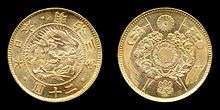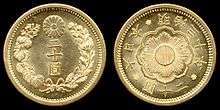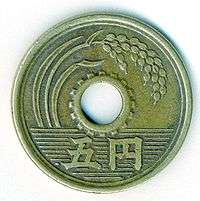20 yen coin
The 20 yen coin (二十圓硬貨) was a denomination of Japanese yen. These coins were minted in gold, and during their lifespan were the highest denomination of coin that circulated in the country. The first coins were minted in 1870 following the introduction of a decimal currency system. Twenty Yen coins spanned three different Imperial eras before mintage was halted in 1932. Many of these coins were then melted or destroyed as a result of the wars between 1931 and 1945. These coins are now collected by numismatists for academic study, and by those with a hobby.
Japan | |
| Value | 20 Japanese yen |
|---|---|
| Mass | 33.3 g |
| Diameter | 35.06 mm |
| Edge | Reeded |
| Shape | Circular |
| Composition | 90% Gold 10% Copper |
| Years of minting | 1870–1932 |
| Catalog number | - |
| Obverse | |
| Reverse | |
History
In November 1869 the new units of yen were established in the form of a metric system. It was decided that silver would become the standard unit of value leaving gold coinage as a subsidiary.[1] The Japanese government considered adopting the gold standard as early as December 1870 after hearing about its implementation in the United States.[1] This system was officially put into place on May 10, 1871 setting standards for the 20 yen coin.[1] While the coins continued to be minted, other changes were being made to the system with new coinage regulations established in 1876 and 1878. For one reason or another these new practices that were put into place were not sufficient to maintain a healthy growth of gold monometallism. Part of the reason was the issuance of large amounts of inconvertible paper currency which drove gold coins out of the country.[2] Coinage of the 20 yen piece had all but stopped by 1877, and those struck in 1880 were only done so as part of presentation sets for visiting dignitaries and heads of state.[3]
New coinage reform was adopted on March 26, 1897 which re-established the gold 20 yen coin. These new standards lowered both the size and weight of the coin, the new diameter was set at 28.78mm (previously 35.06mm) while the weight was lowered from 33.3g down to 16.6g.[4][5] Over 1.5 million coins were struck during this year before production ceased until 1904.[lower-alpha 1] Coinage of 20 yen pieces were then continued past the reign of Emperor Meiji, into the reign of Emperor Taishō where coinage stopped in 1920. The decision to stop coinage of 20 yen pieces came as Japan's gold reserves were quickly depleting from excess imports.[7] The gold reserves were eventually stabilized which allowed coinage to resume in 1930, though gold coins were described as "not in general use".[8] This resumed coinage was brief under Emperor Shōwa as Japan abandoned the gold standard in December 1931.[9] The reasons behind this move were that Japan's gold reserves were again being depleted, and allowing the yen to depreciate would help the economy which was struggling at the time.[10] Gold coins of the 20 yen denomination were last minted in 1932, it is unknown how many Shōwa era coins were later melted. Some of these coins were kept away in bank vaults for decades before being released as part of a hoard in the mid 2000s.[11][12]
Circulation figures
Meiji
The following are mintage figures for the coins that were minted between the 3rd and 45th (last) year of Meiji's reign. Inscriptions on coins for this period all begin with the Japanese symbol 明治 (Meiji). While coins were struck in 1892, none were released for circulation.
Japanese coins from this period are read clockwise from right to left
- "Year" ← "Number representing year of reign" ← "Emperors name" (Ex: 年 ← 七十三 ← 治明)

Design 1 - (1870 - 1892)

Design 2 - (1897 - 1912)[lower-alpha 2]
| Year of reign | Japanese date | Gregorian date | Mintage[13] |
|---|---|---|---|
| 3rd | 三 | 1870 | 46,139[5] |
| 6th | 六 | 1873 | 42,845[14] |
| 7th | 七 | 1874 | 3,251[14] |
| 9th | 九 | 1876 | 954[5] |
| 10th | 十 | 1877 | 29[5] |
| 13th | 三十 | 1880 | 103[5] |
| 25th | 五十二 | 1892 | Not circulated[5] |
| 30th | 十三 | 1897 | 1,861,000[15] |
| 37th | 七十三 | 1904[lower-alpha 1] | 2,759,470 |
| 38th | 八十三 | 1905 | 1,045,904 |
| 39th | 九十三 | 1906 | 1,331,332 |
| 40th | 十四 | 1907 | 817,363 |
| 41st | 一十四 | 1908 | 458,082 |
| 42nd | 二十四 | 1909 | 557,882 |
| 43rd | 三十四 | 1910 | 2,163,644 |
| 44th | 四十四 | 1911 | 1,470,057 |
| 45th | 五十四 | 1912 | 1,272,450 |
Taishō
The following are mintage figures for the coins that were minted from the 1st to the 9th year of Taishō's reign. Inscriptions on coins for this period all begin with the Japanese symbol 大正 (Taishō).
Japanese coins from this period are read clockwise from right to left:
- "Year" ← "Number representing year of reign" ← "Emperors name" (Ex: 年 ← 六 ← 正大)
| Year of reign | Japanese date | Gregorian date | Mintage[13][16] |
|---|---|---|---|
| 1st | 元 | 1912 | 177,644 |
| 2nd | 二 | 1913 | 869,248 |
| 3rd | 三 | 1914 | 1,042,890 |
| 4th | 四 | 1915 | 1,509,960 |
| 5th | 五 | 1916 | 2,376,641 |
| 6th | 六 | 1917[lower-alpha 3] | 6,208,885 |
| 7th | 七 | 1918 | 3,118,647 |
| 8th | 八 | 1919 | 1,531,217 |
| 9th | 九 | 1920 | 370,366 |
Shōwa
The following are mintage figures for coins minted between the 5th and the 7th year of Emperor Shōwa's reign. Inscriptions on coins of this period all begin with the Japanese symbol 昭和 (Shōwa).
Japanese coins from this period are read clockwise from right to left:
- "Year" ← "Number representing year of reign" ← "Emperors name" (Ex: 年 ← 五 ← 和昭)
| Year of reign | Japanese date | Gregorian date | Mintage[13] |
|---|---|---|---|
| 5th | 五 | 1930 | 11,055,500 |
| 6th | 六 | 1931 | 7,526,476 |
| 7th | 七 | 1932 | Unknown |
Collectability
All 20 yen coins are scarce as the amount remaining today are dependent on how many were saved or kept away. The most common coins found date between 1904 and 1920 (Meiji Y.37 to Taishō Y.9), with examples selling in the thousands of dollars both online and at auction.[18] These more common coins include one of the highest mintages of the series that occurred in 1917 (year 6) during Taishō's reign. Early Meiji era coins are harder to find than coins dated after 1896, and except for the rarest issues are all priced in five digit amounts.[19] The rarest of these early issue coins include those made between 1876 and 1880 (year 9 to 13) as mintage totals dropped off during this period. Coins dated 1880 (year 13) were only released as part of presentation sets[lower-alpha 4] that were widely destroyed or melted down between 1931 and 1945.[20] Less than 10 coins dated 1880 (year 13) of the original mintage of 103 are thought to exist today, one of these pieces sold for $230,000 (USD) in 2011.[20] The lowest known mintage of the series occurred in 1877 (year 10) with 29 coins struck, only 1 mint state example is recorded by PCGS.[21]
Millions of minted coins were recorded during the Shōwa era, but it is unclear how many of these coins survived. Examples from Shōwa's 7th year of reign (1932) were once considered to be virtually unknown until a hoard was discovered in the mid 2000s. Between 2005 and 2007 the Ministry of Finance released over 30,000 gold coins of 5, 10 and 20 Yen denominations that had been kept in vaults.[12][22] It is recommended by those in the numismatic field that all 20 yen coins be authenticated first by an expert, as counterfeits exist.[19]
See also
Notes
- 1903 dated coins are mentioned in annual coinage reports.[6]
- The 2nd design was used until the series ended in 1932.
- 5 pieces were struck in platinum sometime in the 1950s for reasons unknown.[17]
- Low mintage 1880 (year 13) dated denominations include: "1 rin", "5 sen", "10 sen", 20 sen", 50 sen", "1 yen" (gold), "2 yen", "10 yen" and "20 yen" coins.
References
- Report of the Adoption of the Gold Standard in Japan. Government Press. 1899. p. 2–8.
- Report of the Adoption of the Gold Standard in Japan. Government Press. 1899. p. 11–12.
- "Meiji Proof gold 20 Yen Year 13 (1880)". Heritage Auctions. Retrieved March 14, 2020.
- "The Coinage Law of Japan, Enacted in 1897". p. 23-25.
- "Japan 20 Yen Y# 13 Yr.10(1877)-Yr.9(1876)". Numismatic Guaranty Corporation. Retrieved December 21, 2016.
- Annual Report of the Director of the United States Mint. United States. Bureau of the Mint. 1903. p. 253.
- Annual Report of the Director of the United States Mint. United States. Bureau of the Mint. 1922. p. 206.
- M. Epstein (1932). The Statesman's Year-Book: Statistical and Historical Annual of the States of the World for the Year 1932. p. 1074.
- Foreign Commerce Yearbook (1935). U.S. Government Printing Office. 1935. p. 295.
- David Flath (2000). The Japanese Economy. Oxford University Press. p. 58.
- "Showa 5 (1930) gold 5 Yen". Heritage Auctions. Retrieved March 24, 2020.
The Showa gold 5 and 20 Yen were essentially unavailable to collectors for over seventy years until the Japanese Finance Minister hoard was released for public auction.
- "Japan Ministry of Finance Holder Coins in Original Holders of Sale". NGC. Retrieved March 18, 2020.
- Chester L. Krause & Clifford Mishler. Collecting World Coins 10th edition. Krause Publications. pp. 433–434.
- "Japan Weekly Mail". Jappan Meru Shinbunsha. 1875. Retrieved December 21, 2016.
- "Japan 20 Yen Y# 34". Numismatic Guaranty Corporation. Retrieved March 28, 2018.
- "Japan 20 Yen Y# 40.2 Yr.2(1913)-Yr.9(1920)". Numismatic Guaranty Corporation. Retrieved December 21, 2016.
- "Japan. Platinum 20 Yen, Year 6 (1917)". Goldberg Coins. Retrieved March 24, 2020.
- "Japan 5, 10, and 20 Yen 1897 to 1932". coinquest.com. Archived from the original on December 22, 2016. Retrieved December 22, 2016.
- "Japan 2, 5, 10, and 20 Yen (Fakes are possible) 1870 to 1900". coinquest.com. Archived from the original on December 23, 2016. Retrieved December 22, 2016.
- Heritage Auction (December 12, 2016). "Japanese Proof Collection Star of Heritage NYINC 2017 Signature Auction". www.coinweek.com. Retrieved December 22, 2016.
- "20 YEN (1870 - 1932)". PCGS. Retrieved March 21, 2020.
- "Showa gold 20 Yen Year 7 (1932)". Heritage Auctions. Retrieved March 18, 2020.
